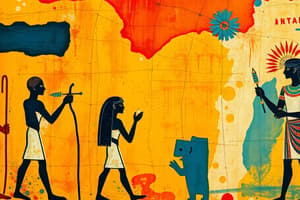Podcast
Questions and Answers
What were the purposes of paintings from the Prehistoric era?
What were the purposes of paintings from the Prehistoric era?
Communicating with each other, religious or ceremonial purposes.
What was the primary purpose of Egyptian paintings?
What was the primary purpose of Egyptian paintings?
To make the deceased's afterlife place pleasant.
Which methods were most common in Greek painting?
Which methods were most common in Greek painting?
- Acrylic
- Fresco (correct)
- Watercolor
- Encaustic (correct)
The method of painting that uses water-based pigments on plaster is called __________.
The method of painting that uses water-based pigments on plaster is called __________.
What were the most common motifs found in Kerch Style vases?
What were the most common motifs found in Kerch Style vases?
What is one of the main innovations in Roman painting compared to Greek painting?
What is one of the main innovations in Roman painting compared to Greek painting?
Tomb paintings used only tempera as a method.
Tomb paintings used only tempera as a method.
What characterized Byzantine paintings?
What characterized Byzantine paintings?
The artwork process where small pieces of materials create an image is known as __________.
The artwork process where small pieces of materials create an image is known as __________.
What was one of the subjects depicted in Gothic era paintings?
What was one of the subjects depicted in Gothic era paintings?
Flashcards are hidden until you start studying
Study Notes
Prehistoric Era Paintings
- Cave paintings, potentially for communication or ceremonial purposes, found in sites like the Cave of Lascaux.
- Date ranges from 5,000 to 10,000 B.C., marking the Stone Age.
Ancient Egyptian Paintings
- Aimed to enhance the afterlife experience for the deceased and preserve knowledge of the past.
- Notable example: Painting from the Sarcophagus of Tutankhamen, dated 1362 A.D. to 1253 B.C.
Classical Greek Paintings
- Commonly located on vases, panels, and tombs; focused on natural figures with dynamic compositions.
- Frequently depicted battle scenes, mythological figures, and daily life, exhibiting linear perspective and naturalism.
- Main painting methods included:
- Fresco: Water-based pigments on wet plaster, creating permanent wall art.
- Encaustic: Hot wax technique originally from shipbuilding, later applied in painting.
Kerch Style Vase Painting
- Red-figured pottery named after the location of discovery.
- Common shapes include pelike (wine container), lekanis (low bowl), lebes gamikos (wedding bath vessel), and krater (wine mixing bowl).
- Common motifs featured the lives of women, with a polycromy technique showcasing vibrant colors.
Panel Painting
- Created on flat wood panels that can be single or multiple pieces; many have not survived due to organic materials.
- Example: Pitsa Panel.
Tomb Painting
- Popular during the classical period, used fresco, tempera, or encaustic techniques.
- Artists employed shades and hues to provide depth and lifelike qualities.
- Example: Tomb of the Diver.
Romantic Era Paintings
- Often imitated Hellenic Greek styles, using fresco techniques with bright backgrounds and multi-point perspectives.
- Depicted diverse subjects including animals, daily life, landscapes, and mythology.
- Noteworthy innovation in landscape painting distinguishing Roman from Greek art.
Mosaic Art
- Created using small colored pieces of glass, stones, or materials, employed for decorative purposes.
Byzantine Painting
- Continued Greek and Roman styles, focusing on Christian subjects with a blend of Greek and Oriental styles by the 11th century.
- Notable example: The Court of Empress Theodora.
Romanesque Painting
- Exhibits variety in artistic traditions, combining Byzantine styles with southern French decorative elements.
- Example: Christ in Majesty.
Gothic Era Paintings
- Predominantly limited to manuscript illumination and church frescoes, characterized by elegance and sophistication.
- Subjects included legends and love stories, with patterns influenced by the Crusades.
- Stained glass windows created vibrant interiors while educating Christians about their faith.
- Featured realistic details combined with a naïve aesthetic.
Studying That Suits You
Use AI to generate personalized quizzes and flashcards to suit your learning preferences.




